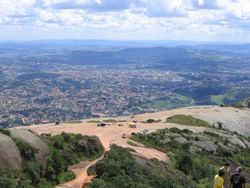Taras Shevchenko
Estância de Atibaia | |
|---|---|
 Central Atibaia | |
| Nickname: Atibaia | |
 Location of Atibaia | |
| Coordinates: 23°07′01″S 46°33′01″W / 23.11694°S 46.55028°W | |
| Country | |
| Region | Southeast |
| State | |
| Founded | June 24, 1665 |
| Area | |
• Total | 478.521 km2 (184.758 sq mi) |
| Elevation | 803 m (2,635 ft) |
| Population (2020 [2]) | |
• Total | 144,088 |
| • Density | 300/km2 (780/sq mi) |
| Time zone | UTC−3 (BRT) |
| Postal code | 12940-000 |
| Area code | +55 11 |
| Website | Atibaia City (in Portuguese) |
Atibaia (or Estância de Atibaia) is a Brazilian municipality in the state of São Paulo.
According to the Brazilian statistics institute the IBGE, the city is a conurbation with Bom Jesus dos Perdões forming the largest urban agglomeration in the Bragantina Region with more than 180 thousand inhabitants.[3]
History
In 1665, Jerônimo de Camargo and his expedition found a hill near a river named Tubaia (later called Atibaia River). Jerônimo de Camargo was a Bandeirante explorer.[4]
Geography
Atibaia is located 64 km north-east of São Paulo[5] and 88 km south-east of Campinas.[4]

Atibaia has 478 square kilometers of area, 40% of this area is urbanized. The average altitude is 800 meters.[citation needed]
Demographics
According to the census of 2007 by the Brazilian Institute of Geography and Statistics (IBGE), Atibaia has approximately 119,166 inhabitants and 65% of the population (95,342 inhabitants) is part of the economically active age group.[citation needed]
Economy
In 2005, The Brazilian Development Bank (BNDES) loaned Atibaia R$2 million, to try to help it improve its city hall management.[6]
Sites of interest
The Museu João Batista Conti, opened in 1954, contains arms, armor, furniture, historical objects, coins and works of religious art along with documents on the colonial and imperial periods in Brazil.[7]
Sister cities
 Goyang, Gyeonggi Province, South Korea
Goyang, Gyeonggi Province, South Korea
See also
References
- ^ "Brazilian Institute of Geography and Statistics" (in Portuguese). 2017. Retrieved 27 March 2019.
2018 Area Total
- ^ IBGE 2020
- ^ "Atibaia - Guia do cidade Atibaia -SP Aqui você Encontra !". www.encontraatibaia.com.br (in Brazilian Portuguese). Retrieved 2024-10-18.
- ^ a b Atibaia, Brazil
- ^ "G1 > Edição São Paulo - NOTÍCIAS - Cinco suspeitos de soltar balão são detidos em Atibaia".
- ^ BNDES lends R$ 2 million to improve Atibaia' s City Hall management Archived June 11, 2007, at the Wayback Machine
- ^ Atibaia Museu Joao Batista Conti, Atibaia Archived November 5, 2007, at the Wayback Machine
External links
- City Hall website (in Portuguese)
- 23°07′02″S 46°33′02″W / 23.11722°S 46.55056°W

 Read
Read
 AUTHORPÆDIA is hosted by Authorpædia Foundation, Inc. a U.S. non-profit organization.
AUTHORPÆDIA is hosted by Authorpædia Foundation, Inc. a U.S. non-profit organization.

